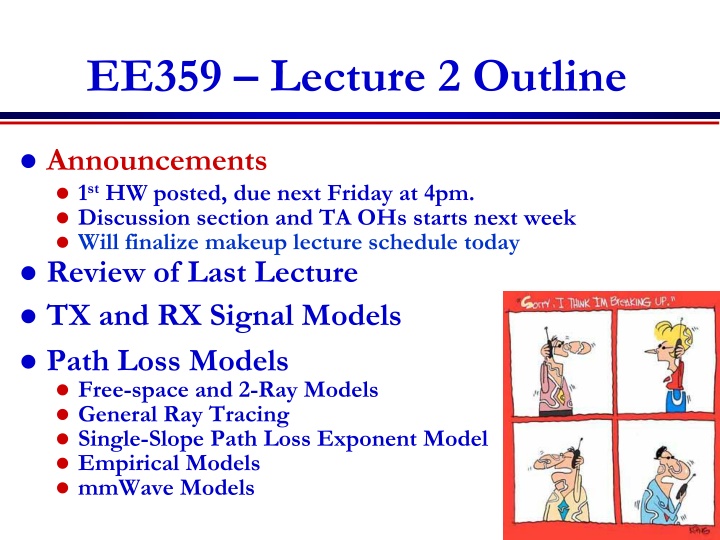
Wireless Communication Propagation Models and Characteristics
Explore the various propagation characteristics in wireless communication, including path loss, shadowing, and multipath fading. Learn about different path loss models such as free-space, two-ray, single-slope, and more. Dive into the complexities of Maxwell's equations and the practical applications of measurement-based models for design assessment.
Download Presentation

Please find below an Image/Link to download the presentation.
The content on the website is provided AS IS for your information and personal use only. It may not be sold, licensed, or shared on other websites without obtaining consent from the author. If you encounter any issues during the download, it is possible that the publisher has removed the file from their server.
You are allowed to download the files provided on this website for personal or commercial use, subject to the condition that they are used lawfully. All files are the property of their respective owners.
The content on the website is provided AS IS for your information and personal use only. It may not be sold, licensed, or shared on other websites without obtaining consent from the author.
E N D
Presentation Transcript
EE359 Lecture 2 Outline Announcements 1stHW posted, due next Friday at 4pm. Discussion section and TA OHs starts next week Will finalize makeup lecture schedule today Review of Last Lecture TX and RX Signal Models Path Loss Models Free-space and 2-Ray Models General Ray Tracing Single-Slope Path Loss Exponent Model Empirical Models mmWave Models
Makeup lecture options Next Thursday Monday (1/13): 11:30-12:50pm w/lunch Tuesday (1/14): 3:00-4:20 or 4:30-5:50pm (+lecture 1:30-2:50) Wednesday (1/15): 9:00-10:20am or 11:30-12:50pm* Regular Time Thu 1:30-2:50pm with Tom giving lecture Friday (1/17): 9:00-10:20am* or 3:30-4:50pm Following Monday is MLK 3-day weekend Thu 2/20 moved to Fri 2/21 from 3:30-4:50pm MT week, could do Fri 9am instead Tue 2/4 moved to Wed 2/5 11:30-12:50pm w/lunch Thu 3/5 moved to Wed 3/4 11:30-12:50pm w/lunch Could do Wed am or Friday 9am or 3:30 instead Regular time with Tom *Pending availability
Lecture 1 Review Course Information Wireless Vision Technical Challenges Current/Next-Gen Wireless Systems Spectrum Regulation and Standards Emerging Wireless Systems Emerging systems can be covered in a bonus lecture
Propagation Characteristics Path Loss (includes average shadowing) Shadowing (due to obstructions) Multipath Fading Slow Fast Pr/Pt Pt Pr Very slow v d=vt d=vt
Path Loss Modeling Maxwell s equations Complex and impractical Free space and 2-path models Too simple Ray tracing models Requires site-specific information Single-slope path loss exponent model Main characteristics: good for high-level analysis Measurement-based and Standards Models Not accurate; used to assess different designs
Free Space (LOS) Model d=vt Path loss for unobstructed LOS path Power falls off : Proportional to 1/d2 Proportional to 2 (inversely proportional to f2) This is due to the effective aperture of the antenna
Two Ray Model Path loss for one LOS path and 1 ground (or reflected) bounce Ground bounce approximately cancels LOS path above critical distance Power falls off Proportional to d2 (small d) Proportional to d4 (d>dc) Independent of (fc) Two-path cancellation equivalent to 2-element array, i.e. the effective aperature of the receive antenna is changed.
General Ray Tracing Models signal components as particles Reflections Scattering Diffraction Reflections generally dominate Requires site geometry and dielectric properties Easier than Maxwell (geometry vs. differential eqns) Computer packages often used 10-ray reflection model explored in HW
Simplified Path Loss Model Used when path loss dominated by reflections. Most important parameter is the path loss exponent , determined empirically. d = , 2 8 0 r P P K r t d
mmWave: Whats the big deal? All existing commercial systems fit into a small fraction of the mmWave band
mmWave Propagation (60-100GHz) mmW Massive MIMO Channel models immature Based on measurements, few accurate analytical models Path loss proportion to 2 (huge) Also have oxygen and rain absorbtion is on the order of a water molecule mmWave systems will be short range or require massive MIMO
Empirical Channel Models (not covered in lecture, not on HW/exams) Early cellular empirical models: Empirical path loss models for early cellular systems were based on extensive measurements. Okumura model: empirically based (site/freq specific), uses graphs Hata model: Analytical approximation to Okumura Cost 231 Model: extends Hata to higher freq. (2 GHz) Multi-slope model Walfish/Bertoni: extends Cost 231 to include diffraction Current cellular models (LTE and 5G): Detailed path loss models for UE (3GPP TS 36.101) and base stations (3GPP TS 36.104) for different multipath delay spreads, user speeds and MIMO antenna correlations. The 5G model includes higher frequencies (up to 100 GHz). WiFi channel models: TGn and TGac Indoor and outdoor path loss models with MIMO (4x4 & greater), 40 MHz channels (& greater), and different multipath delay spread. Commonly used in cellular and WiFi system simulations
Main Points Path loss models simplify Maxwell s equations Models vary in complexity and accuracy Power falloff with distance is proportional to d2 in free space, d4 in two path model Main characteristics of path loss captured in single-slope exponent model Pr=PtK[dr/d] mmWave propagation models still immature Path loss large due to frequency, rain, and oxygen Empirical models used in simulations
